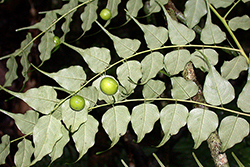e-Flora of Thailand
Volume 5 > Part 3 > Year 1991 > Page 249 > Capparaceae > Capparis
9. Capparis acutifolia Sweetwfo-0000584458
Hort. Brit. ed. 2: 585. 1830; Jacobs, Blumea 12: 426. 1963. p.p., excl. ssp. sabiaefolia (Hook.f. & Thomson) Jacobs and ssp. obovata Jacobs.
Accepted Name : This is currently accepted.
Synonyms & Citations :
Description : Shrub or small tree, 1.5–4 m; branches glabrous, sometimes brown tomentose, soon or tardily glabrescent; thorns straight, 2–3 mm long, or wanting. Leaves elliptic, sometimes ovate, 4.5–9 by 2.5–4.5 cm, papery, sometimes subcoriaceous; base acute or cuneate; apex abruptly acuminate, tip up to 1 cm; nerves 4–5 pairs, arched. Petiole 4–8 mm. Flowers arranged in supra-axillary rows. Pedicels 13–20 mm. Sepals 4–5 by 2–2.5 mm, outside glabrous, inside tomentose, ciliate. Petals oblong, 7 by 2.5–3 mm, densely tomentose on both sides, ciliate. Gynophore 7–22 mm, glabrous, rarely thinly puberulous towards the base. Ovary ovoid or ellipsoidal, 1–1.5 by 1 mm, glabrous. Fruits globose, 1–1.5 cm in diam.; pericarp thin, smooth; stipe 3–4 cm, slender.
Thailand : NORTHERN: Chiang Mai (Doi Chiang Dao), Lampang, Tak (Doi Pae Poe); NORTH-EASTERN: Loei (Tha Li).
Distribution : India (type), China, Indochina.
Ecology : In evergreen forests and bamboo forests, 50–2,000 m alt. Flowering: March–May; fruiting: June.
Notes: All Thai specimens cited under subsp. obovata Jacobs and subsp. sabiaefolia (Hook.f. & Thoms.) Jacobs are treated as Capparis sabiifolia Hook.f. & Thorns. (p. 247).

